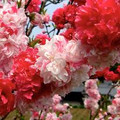的点评
Locally revered shrine
栉田神社的点评
点评:Although the temple entrance is squeezed up against several buildings from the outside, once you enter you easily forget the world outside. The grounds are small and compact but there is much to see. You could easily spend a pleasant hour here.
Last time we visited the shrine, the main worship hall was closed. This time we were luckier - the honden was open. Unfortunately, there was construction going on in several other buildings in the shrine compound. We visited during Shichi-Go-San, which seems to be celebrated for several days, and it was fun to see parents and grandparents out with their children decked out in traditional dress. Many family groups were visiting the shrine and posing for photos, indicative of the importance of the shrine for the local population.
We were glad to see that the 1000 year old ginkgo tree was still thriving. The festival float was still on display in its kura. We were not there during the Hakata Gion Yamakasa Festival, but fortuitously yesterday, July 15, was the final day of the festival and there was a program on TV about the festival. It is definitely something I would like to see, but July is not when we visit Japan.
Last time we visited the shrine, the main worship hall was closed. This time we were luckier - the honden was open. Unfortunately, there was construction going on in several other buildings in the shrine compound. We visited during Shichi-Go-San, which seems to be celebrated for several days, and it was fun to see parents and grandparents out with their children decked out in traditional dress. Many family groups were visiting the shrine and posing for photos, indicative of the importance of the shrine for the local population.
We were glad to see that the 1000 year old ginkgo tree was still thriving. The festival float was still on display in its kura. We were not there during the Hakata Gion Yamakasa Festival, but fortuitously yesterday, July 15, was the final day of the festival and there was a program on TV about the festival. It is definitely something I would like to see, but July is not when we visit Japan.
翻译:虽然寺庙入口从外面看与几座建筑夹道而行,但一旦进入,您就会轻易忘记外面的世界。寺院面积虽小,但值得一看的地方却很多。您可以在这里度过一个愉快的时光。
上次我们参观神社时,主殿关闭了。这次我们比较幸运——本殿开放了。不幸的是,神社内的其他几座建筑正在施工。我们参观的时候正值七五三节,这个节日似乎要持续好几天,看到父母和祖父母带着穿着传统服饰的孩子们外出,真是令人开心。许多家庭团体前来参拜,并摆姿势拍照,这体现了神社对当地居民的重要性。
我们很高兴地看到,那棵千年古银杏树依然枝繁叶茂。节日彩车仍在藏中展出。我们没去参加博多祇园山笠祭,不过碰巧昨天(7月15日)是祭典的最后一天,电视上正好有关于祭典的节目。我当然想去看看,不过七月可不是我们去日本的时间。
上次我们参观神社时,主殿关闭了。这次我们比较幸运——本殿开放了。不幸的是,神社内的其他几座建筑正在施工。我们参观的时候正值七五三节,这个节日似乎要持续好几天,看到父母和祖父母带着穿着传统服饰的孩子们外出,真是令人开心。许多家庭团体前来参拜,并摆姿势拍照,这体现了神社对当地居民的重要性。
我们很高兴地看到,那棵千年古银杏树依然枝繁叶茂。节日彩车仍在藏中展出。我们没去参加博多祇园山笠祭,不过碰巧昨天(7月15日)是祭典的最后一天,电视上正好有关于祭典的节目。我当然想去看看,不过七月可不是我们去日本的时间。
此点评仅代表旅行者个人的主观意见,并不代表TripAdvisor以及其合作方的意见。
关于我们
|
新闻动态
|
商务合作
|
会员中心
|
业主中心
|
业主通
|
常见问题
|
意见反馈
|
联系我们
|
营业执照
© 2025 Tripadvisor 版权所有。
使用条款 |隐私政策 |网站工作原理
部分照片由 VFM Leonardo 提供。
* Tripadvisor不是旅行社,也不是旅游预订服务代理商。我们提供免费、客观、公正的旅游资讯服务。 (显示更多)
TripAdvisor LLC 既不是预订代理商,也不是旅游运营商,不会向网站用户收取任何服务费。 按照规定,在 Tripadvisor 发布机票价格、游览和旅行套餐的合作伙伴(航空公司、旅行提供商及预订代理商),其标价须包含所有费用和附加费用。 例如, 机场出入境税费、消费税与其他服务费、手续费、杂费及附加费用。 当您向我们的某个合作伙伴进行预订时,请务必查阅他们的网站以了解当地行政部门要求的所有适用费用的具体情况。 除非另有说明,机票价格通常指的是一个人的价格(以人民币计)。
为方便起见,TripAdvisor LLC 根据从我们的预订合作伙伴获取的空房率计算每个酒店的均价。 对于游览和景点来说,所显示价格通常是每位成人的最低可用价格。 对于列出的任何旅行套餐或优惠,TripAdvisor LLC 无法保证任何特定的费率或价格。 此外,酒店均价每晚会更新,并以您的首选币种表示(使用现行汇率)。 由于这些已换算的价格是预估价格,因此,有关具体金额和币种请与预订网站进行核实。
此外,TripAdvisor LLC 无法保证我们网站上宣传的价格随时有效。 标价可能需要预订一定天数才能生效,或有不可用日期、使用条件或限制。
TripAdvisor公司对外部网站的内容一概不负责。优惠价格中不含税和其他费用。
ICP证:沪B2-20200433
沪ICP备20013175号
 沪公网安备31010502005427号
沪公网安备31010502005427号鹰程信息技术(上海)有限公司
货币/国家及地区
¥CNY
中国

